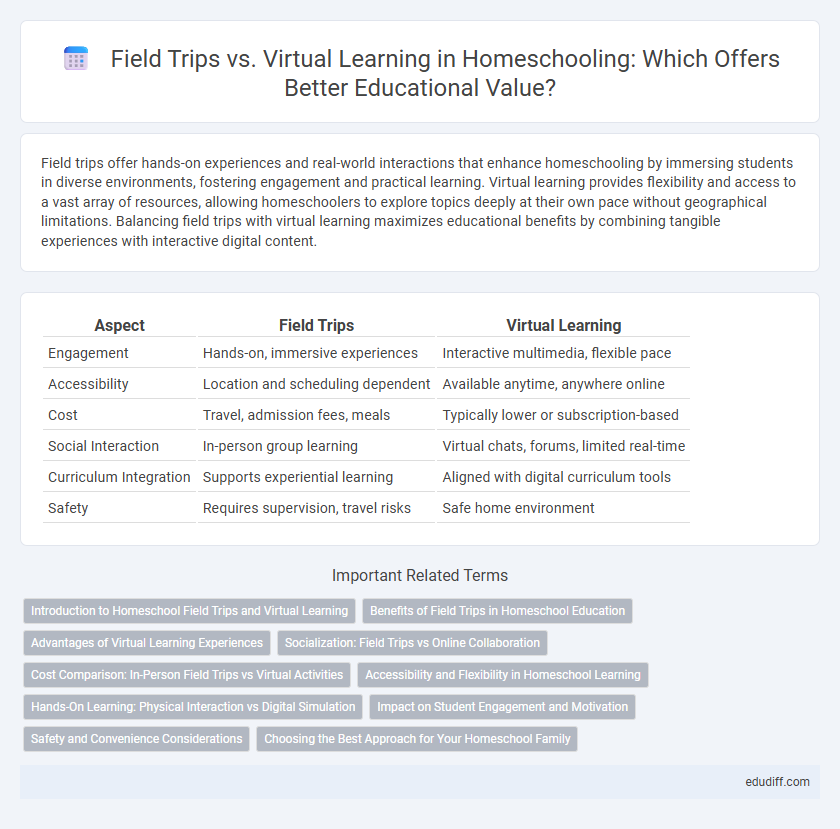Field trips offer hands-on experiences and real-world interactions that enhance homeschooling by immersing students in diverse environments, fostering engagement and practical learning. Virtual learning provides flexibility and access to a vast array of resources, allowing homeschoolers to explore topics deeply at their own pace without geographical limitations. Balancing field trips with virtual learning maximizes educational benefits by combining tangible experiences with interactive digital content.
Table of Comparison
| Aspect | Field Trips | Virtual Learning |
|---|---|---|
| Engagement | Hands-on, immersive experiences | Interactive multimedia, flexible pace |
| Accessibility | Location and scheduling dependent | Available anytime, anywhere online |
| Cost | Travel, admission fees, meals | Typically lower or subscription-based |
| Social Interaction | In-person group learning | Virtual chats, forums, limited real-time |
| Curriculum Integration | Supports experiential learning | Aligned with digital curriculum tools |
| Safety | Requires supervision, travel risks | Safe home environment |
Introduction to Homeschool Field Trips and Virtual Learning
Homeschool field trips provide hands-on educational experiences that enhance real-world learning and social interaction, offering opportunities to explore museums, nature centers, and historical sites. Virtual learning delivers flexible, curriculum-rich instruction through online platforms, allowing students to access diverse resources and expert-led lessons from home. Both methods support personalized education, catering to varied learning styles and schedules while enriching the homeschool curriculum.
Benefits of Field Trips in Homeschool Education
Field trips in homeschool education provide immersive, hands-on learning experiences that enhance student engagement and retention. Visiting museums, nature reserves, and cultural landmarks offers real-world context, fostering critical thinking and curiosity beyond traditional textbooks. These excursions also promote social skills and community connections essential for holistic development in homeschool environments.
Advantages of Virtual Learning Experiences
Virtual learning experiences offer unparalleled access to diverse educational content from global locations without the need for travel, making them cost-effective and time-efficient for homeschooling families. Interactive digital tools and virtual reality simulations enhance engagement and allow personalized learning paces tailored to individual student needs. These experiences also provide safe learning environments, reducing health risks and logistical challenges associated with organizing physical field trips.
Socialization: Field Trips vs Online Collaboration
Field trips offer homeschooling students direct social interaction with peers, fostering communication skills and teamwork in dynamic, real-world environments. Virtual learning emphasizes online collaboration tools, enabling students to engage in group projects and discussions across diverse geographic locations. Both methods support socialization, but field trips provide tangible, multisensory experiences, while online collaboration develops digital communication competencies.
Cost Comparison: In-Person Field Trips vs Virtual Activities
In-person field trips typically incur higher costs due to transportation, admission fees, and meals, averaging $20 to $50 per student per outing. Virtual learning activities offer a cost-effective alternative with subscription fees or one-time purchases often under $15 per participant, eliminating travel expenses. Homeschool families benefit from virtual programs that provide diverse educational experiences while maintaining budget flexibility and convenience.
Accessibility and Flexibility in Homeschool Learning
Field trips offer hands-on learning experiences that enhance understanding and engagement but often require significant planning, travel, and expense, which can limit accessibility for some homeschooling families. Virtual learning provides unparalleled flexibility, allowing students to access diverse resources and interactive content from any location at any time, accommodating varied schedules and learning paces. Combining both methods can optimize educational outcomes by balancing immersive, real-world experiences with adaptable, technology-driven instruction.
Hands-On Learning: Physical Interaction vs Digital Simulation
Field trips provide hands-on learning through direct physical interaction with environments, allowing students to engage all senses and foster deeper cognitive connections. Virtual learning relies on digital simulations that offer visual and auditory experiences but may lack tactile feedback and spontaneous exploration opportunities. Balancing field trips with virtual tools enhances comprehension by combining immersive real-world activities with flexible, technology-driven content.
Impact on Student Engagement and Motivation
Field trips provide hands-on, immersive experiences that significantly boost student engagement and motivation by connecting learning to real-world environments. Virtual learning offers flexibility and access to diverse resources, yet often struggles to replicate the sensory and social benefits of in-person exploration. Research shows that combining both methods can enhance motivation by balancing interactive experiences with convenient, tailored educational content.
Safety and Convenience Considerations
Field trips provide hands-on learning experiences but pose safety risks such as transportation accidents and exposure to unfamiliar environments. Virtual learning eliminates physical travel hazards, offering a safe alternative while maintaining access to diverse educational content. Parents often prioritize convenience and risk management, making virtual field trips a practical choice for homeschool safety.
Choosing the Best Approach for Your Homeschool Family
Field trips provide hands-on experiences that enhance understanding through real-world exploration, making them valuable for kinesthetic learners and family bonding. Virtual learning offers flexibility, access to diverse resources, and the ability to tailor lessons to individual interests, fitting families with tight schedules or remote locations. Assessing your homeschool family's learning preferences, time availability, and educational goals ensures the best approach blends experiential and digital learning effectively.
Field Trips vs Virtual Learning Infographic

 edudiff.com
edudiff.com